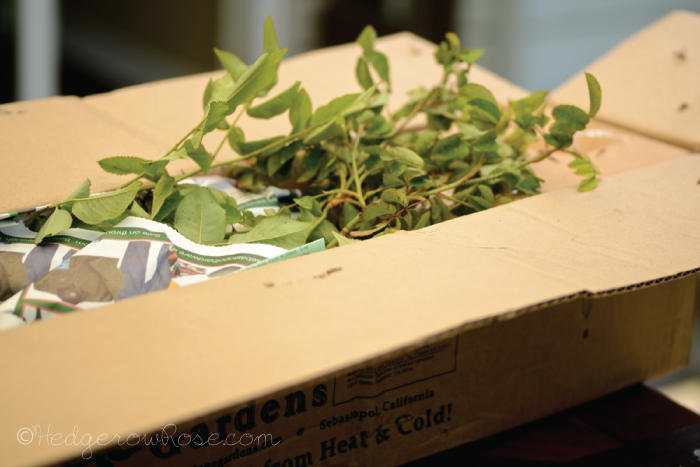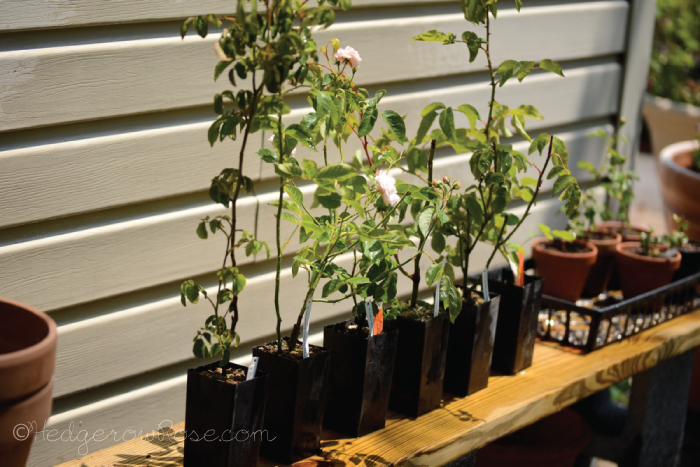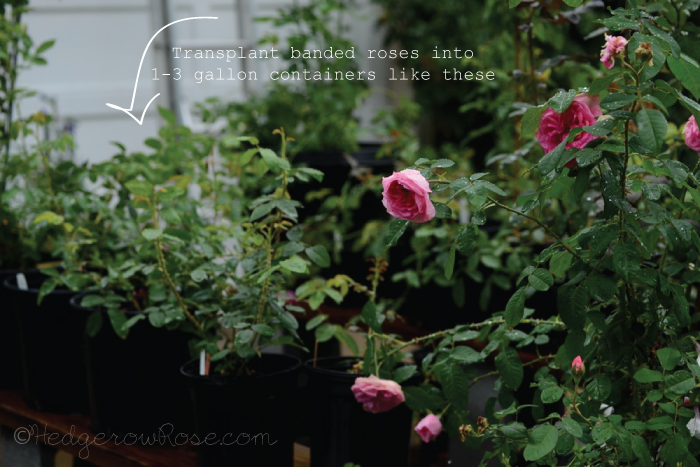Purchasing “Banded” Roses and Introducing Them to Your Garden

Banded roses, such as this R. rubiginosa shown above, will arrive in a slender 4″x 6″ nursery pot. Depending on when they are ordered and delivered to you, they just might give you some blooms in their first season.
You hear a lot about “banded” roses, but what are they? A rose that is labeled a “band” is one that is grown from a cutting, in it’s first year of growth (on it’s own root system versus grafted onto another root stock like this) and is potted up in a slender, small container–typically 4″ x 6″. What’s the appeal? Well, for me, I love the variety of roses available as a band, and you will too, especially if you’re into Old Garden and/or rare and unusual roses. Second, I’m a fan of roses grown on their own roots, which all banded roses are. And third, I actually like that they’re small–initially. I can build up a collection while giving me time to figure out where I’m going to put all of these roses! (Side note: banded roses are not always the least expensive way to purchase roses, although in many cases they will run you about $10 less.)
Since I’ve been purchasing most of my roses as bands, I thought I would share some things that I’ve learned along the way to help you get started in case you would like to try your hand at them, too.
1.) Roses will be shipped to you at the best planting time for your area. When they arrive, remove them from the box as soon as possible. They will most likely be wrapped in damp, shredded newspaper with the pots enclosed in a plastic baggie to prevent moisture loss and taped to one another so that they wouldn’t shift during transit. Using a sharp pair of scissors, cut the bindings and bags away from the roses. Do this very carefully as it’s likely their canes and leaves will be intermingled.

Carefully remove your roses from their shipping materials as soon as possible
2.) Your roses will probably be thirsty from transit so be sure to give them a nice long drink of water. Because they are usually a little top-heavy in their tall, narrow containers, I like to place them in a washbin (such as a galvanized bin as seen in this post) to keep them from tipping over. Some gardeners transplant their banded roses immediately, but I find that they can go a few days still in their little pots if they’re kept out of all-day sunlight and not allowed to dry out.
3.) When you do transplant, pot them up in a 1-3 gallon size container with your potting soil of choice. I use a compost-based potting mix but I DO NOT USE any chemical (including time-release) fertilizers which can harm (and possibly kill) the tender roots of these tiny roses.

Give your new roses some water, transplant to a 1-3 gallon sized container within a couple of days and keep them in quarantine for about a week
4.) I like to keep my banded roses in quarantine for about 1 week separate from my other container roses to check for any diseases or pests that may have traveled with them.
5.) Depending on the variety, your rose may need to be transplanted again to a large container or planted out into your garden. (My “Arcata Pink Globe” and ‘Georges Vibert’ roses showed epic growth last summer.) Most, however, will need a season or two in these 1-3 gallon containers before they are ready for the garden or another container.
6.) I like to use alfalfa tea and compost tea during the summer growing months on all my container roses including these young introductions. I feel like they really respond to it and that it stimulates growth. (You can make your own, but I purchase my teas at Haven.)

Once out of quarantine and in their new containers, they can join your other container plants and receive organic fertilizers such as compost and alfalfa tea
I truly feel that if you have a little patience, purchasing own-root banded roses is a great way to add a little spice to your rose garden. You’ll find that in just a few seasons, most likely less, you’ll have a big, healthy, beautiful rose that’s giving you lots of blossoms and you won’t believe that it started out as this itty-bitty thing. It’s like that old adage: First year they sleep, second year they creep, third year they LEAP!

Hello! This post is very helpful as I’m new to banded roses. Question: what do you doing in the winter months? Are these roses hardy enough to sit in a 1 gal. pot unprotected? I live in zone 7/8 where it occasionally gets down to 13 degrees (Portland, OR).
Hi Jen! We’re in zone 6 which is much too cold to leave them out unprotected. We bring all our container roses into our garage to be safe. Here’s a post I wrote a while back about tips for protecting roses over winter. Maybe it will help!
This was so helpful! I also live in zone 6!
Thank you Elma! I appreciate you being here! 🙂
I only buy own-root roses. I’m in zone 5 with a very short growing season. To attest to their hardiness, I misplaced a Lunar Mist climbing rose, still in it’s little nursery pot, in some rubble when I was cleaning the garden of debris. It was stepped on, lost it’s soil, left out all winter, roots exposed with very little pot left and no protection. That part of the garden went untouched the following year, and wasn’t found until the next year. Still alive, I planted it and it just burst into new growth, quickly developed buds and grew into a beautiful climber. Voles got to it last year and ate the roots from under it, so I lost it. Own root roses are hardy and want to grow. They need no winter protection in zone 5, so they’re wonderful for lazy gardeners like me. A bonus is that the suckers are true and can be treated as new plants. The very best own root roses I know of are from Northland Rosarium in Spokane, WA. Carol, the owner, is a knowledgable rosarian and the gardens behind her greenhouses are magnificent.
So true!!
Thanks for the tip about Northland Rosarium!